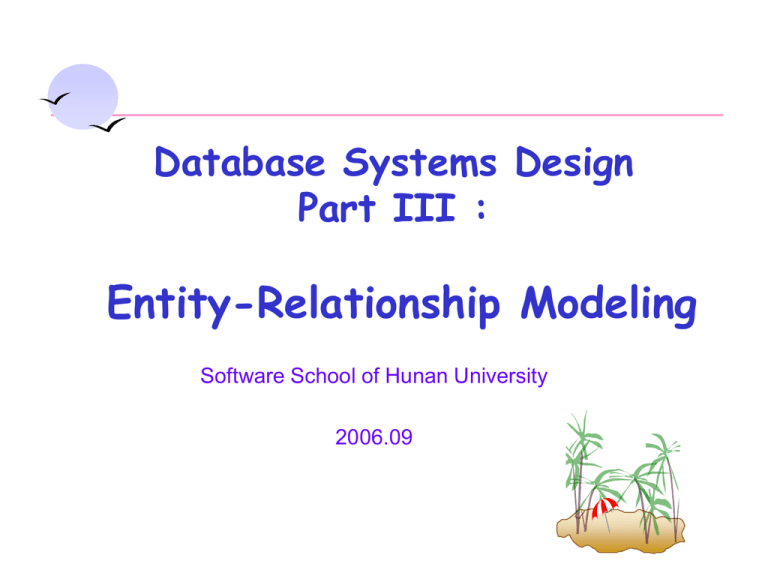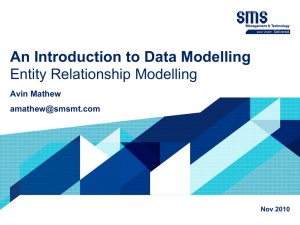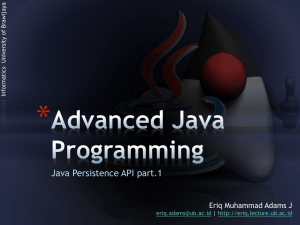
Database Systems Design
Part III :
Entity-Relationship Modeling
Software School of Hunan University
2006.09
Last Lesson Overview
Requirements Specification
Database Design
Application Planning
Conceptual DB Design
Application Design
Logical DB Design
Application Implementation
Physical DB Design
Database Implementation
Testing
Maintenance
Database Design Flow Diagram
Individual
Part 1
Individual
Part n
Intelligence
Identify
Summary
Abstract
Deduce, Refine
ER-diagram
Transformation
User view 1
User view n
Rational
Relations
Relations
Normalization
Conceptual Database Design
Conceptual database design involves modeling the
collected information at a high-level of abstraction
without using a particular data model or DBMS.
Since conceptual database design occurs
independently from a particular DBMS or data model,
we need high-level modeling languages to perform
conceptual design.
The most popular database design language is the
entity-relationship model proposed by Peter Chen in
1976. It is still in use today, but the ER model constructs
are being merged with the modeling constructs of Unified
Modeling Language (UML).
Entity-Relationship Modeling
Entity-relationship modeling is a top-down approach to
database design that models the data as entities, attributes,
and relationships.
The ER model refines entities and relationships by
including properties of entities and relationships called
attributes, and by defining constraints on entities,
relationships, and attributes.
The ER model conveys knowledge at a high-level
(conceptual level) which is suitable for interaction with
technical and non-technical users.
Since the ER model is data model independent, it can
later be converted into the desired logical model (e.g.
relational model).
Example Relation Instances
Employee Relation
ENo
EName
BDate
Title
Salary
SuperNo
DNo
E1
J. Doe
01-05-75
EE
30000
E2
null
E2
M. Smith
06-04-66
SA
50000
E5
D3
E3
A. Lee
07-05-66
ME
40000
E7
D2
E4
J. Miller
09-01-50
PR
20000
E6
D3
E5
B. Casey
12-25-71
SA
50000
E8
D3
E6
L. Chu
11-30-65
EE
30000
E7
D2
E7
R. Davis
09-08-77
ME
40000
E8
D1
E8
J. Jones
10-11-72
SA
50000
null
D1
Example Relation Instances(2)
Department Relation
Project Relation
DNo
DName
MgrNo
PNo
PName
Budget
D1
Management
E8
P1
Instruments
150000
D2
Consulting
E7
P2
DB Develop
135000
D3
Accounting
E5
P3
Budget
250000
D4
Development
null
P4
Maintenance
310000
P5
CAD/CAM
500000
Example Relation Instances(3)
WorksOn Relation
ENo
PNo
Resp
Duration
E1
E2
E2
E3
E3
E4
E5
E6
E7
P1
P1
P2
P3
P4
P2
P2
P4
P3
Manager
Analyst
Analyst
Consultant
Engineer
Programmer
Manager
Manager
Engineer
12
24
6
10
48
18
24
48
36
ER Model Example (historical
notation)
Duration
Name
ENo
Employee
PName
N
Salary
Title
Street
Postcode
M
Project
Budget
Responsibility
Address
City
WorkOn
PNo
TotalEmp
Location
ER Model Example (UML
notation)
Supervises
0..1
Supervisor
0..*
Supervisee
Employee
Eno (PK)
Name
Address
Manage
0..1
0..*
0..*
Has
0..1
Dept
DNo (PK)
Name
0..1
City
Street
PostCode
Has
Title
Salary
0..*
WorkOn
0..*
0..*
Responsibility
Duration
Project
PNo (PK)
Name
Budget
Location[1..3]
/TotalEmp
Entity Types
An entity type is a group of objects with the same properties
which are identified as having an independent existence.
• An entity type is the basic concept of the ER model and
represents a group of real-world objects that have properties.
•
Note that an entity type does not always have to be a physical real-world
object such as a person or department, it can be an abstract concept such as
a project or job.
An entity instance is a particular example or occurrence of
an entity type.
•
For example, an entity type is Employee. A entity instance is 'E1 - John
Doe'.
An entity set is a set of entity instances.
Representing Entity Types
In both classical ER notation and UML, entity types
are represented by rectangles with the name of the
entity type in the rectangle.
Examples:
Employee
•
Project
An entity type name is normally a singular noun. That is,
use Person instead of People, Project instead of Projects, etc.
• The first letter of each word in the entity name is capitalized.
•
Note that colors are irrelevant when representing entity
types (and all other constructs) and are only used for aesthetics.
Relationship Types
A relationship type is a set of meaningful associations
among entity types. Each relationship type is given a name that
describes its function.
A relationship instance is a particular occurrence of a
relationship type that relates entity instances.
For example, WorksOn is a relationship type. A relationship instance is
that 'E1' works on project 'P1' or (E1,P1).
A relationship set is a set of relationship instances.
Note that there can be more than one relationship between two entity
types.
Visualizing Relationships
E1
R1
E2
R2
E3
E4
P1
R3
R4
P3
E5
R5
E6
R6
E7
P2
R7
P4
P5
R8
Note: This is an example of a many-to-many relationship. A
project can have more than one employee, and an employee
can work on more than one project.
Representing Relationship Types
In classical ER notation, a simple relationship type between
two entities is represented as a named diamond that connects
the two entity types.
Employee
Works
On
Project
In UML, the relationship type is represented as a label edge
between the two entity types. The label is applied only in one
direction so an arrow indicates the correct way to read it.
WorksOn
Employee
Project
A relationship type name is normally a verb or verb phrase.
The first letter of each word in the name is capitalized.
Relationship Degree
The degree of a relationship type is the number of entity
types participating in the relationship.
•
For example, WorksOn is a relationship type of degree two
as the two participating entity types are Employee and Project.
Relationships of degree two are binary, of degree three are
ternary, and of degree four are quaternary.
Relationships of arbitrary degree N are called n-ary.
Both UML and classical ER notation use a diamond to
represent relationships of degree higher than two.
Relationship Degree
Staff
Register
Branch
Client
Registeration of a client by a staff at a branch
Solicitor
Buyer
Arranges
Bid
Financial
institution
Recursive Relationships
A recursive relationship is a relationship type where the same
entity type participates more than once in different roles.
• For example, an employee has a supervisor. The supervisor is also an
employee.
ER notation:
Supervises
Supervisor
Employee
Supervisee
Role name
In UML notation, each role has a role name:
Supervises
Supervisor
Supervisee
Employee
Recursive Relationships (2)
the same entity type participates more than once in different
roles
Manager
Department
Manages
Employee
Has
Member of staff
Role name
Department
Department office
Attributes
An attribute is a property of an entity or a relationship type.
For example, entity type Employee has attributes name,
salary, title, etc.
Some rules:
•
By convention, attribute names begin with a lower case
letter.
•
Each attribute has a domain which is the set of allowable
values for the attribute.
•
Different attributes may share the same domain, but a single
attribute may have only one domain.
Simple and Complex Attributes
An attribute is a simple attribute if it contains a single component
with an independent existence.
•
For example, salary is a simple attribute.
Simple attributes are often called atomic attributes.
An attribute is a composite attribute if it consists of multiple
components each with an independent existence.
•
For example, address is a complex attribute because it consists of
postcode ,street and city components (subattributes).
Question: Is the name attribute of Employee simple or Complex ?
Single- and Multi-Valued
Attributes
An attribute is a single-valued attribute if it consists of a single
value for each entity instance.
•
For example, salary is a single-valued attribute.
An attribute is a multi-valued attribute if it may have multiple
values for a single entity instance.
• For example, a telephone number attribute for a person may be
multivalued as people may have different phone numbers (home
phone number, cell phone number, etc.)
A derived attribute is an attribute whose value is calculated from
other attributes but is not physically stored.
•
The calculation may involve attributes within the entity type of the
derived attribute and attributes in other entity types.
Constraints on Entity - Keys
A candidate key is a minimal set of attributes that uniquely
identifies each instance of an entity type.
• For example, the number attribute uniquely identifies an Employee and is a
candidate key for the Employee entity type.
A primary key is a candidate key that is selected to identify each
instance of an entity type.
The primary key is chosen from a set of candidate keys.
For instance, an employee may also have SSN as an attribute. The primary
key may be either SSN or number as both are candidate keys.
A composite key is a key that consists of two or more attributes.
• For example, a course is uniquely identified only by the department code
(22C) and the course number within the department (144).
Representing Attributes
The ER and UML notations differ widely on how attributes are
represented. UML notation is nice because it is compact.
In the ER model, attributes are ovals with the name of the attribute
in the oval, and the oval is connected to its entity type.
• There are different types of ovals for the different attribute types
(key attribute, multivalued, composite).
In UML, attributes are listed in the rectangle for their entity. Tags
are used to denote any special features of the attributes:
• primary key: {PK}, partial primary key: {PPK}, alternate key: {AK}
• derived attribute: /attributeName (e.g. /totalEmp)
• multi-valued attribute: attributeName [minVals..maxVals]
e.g. phoneNumber [1..3]
Attributes on Relationships
An attribute may be associated with a relationship type.
• For example, the WorksOn relationship type has two attributes:
responsibility and duration.
Note that these two attributes belong to the relationship and cannot belong
to either of the two entities individually (as they would not exist without the
relationship).
Relationship attributes are represented the same as
entity type attributes in the ER model.
In UML, there are represented as a separate box
connected to the relationship using a dotted line.
ER Model Example (historical
notation)
Primary Key
Relationship Attribute
Duration
Name
ENo
Employee
N
Street
Postcode
M
Project
Budget
Responsibility
Address
City
WorkOn
Salary
Title
PNo
PName
Composite
Atrribute
TotalEmp
Location
Derived
Attribute
Multi-value
Attribute
ER Model Example (UML
notation)
Supervises
0..1
Supervisor
0..*
Supervisee
Employee
eno (PK)
Primary Key name
address
Composite
Atrribute
Manager
Manage
0..1
0..*
Staff
0..*
Has
0..1
Department
dno (PK)
name
0..1
city
street
postCode
Has
title
salary
0..*
WorkOn
0..*
Relationship Attribute
0..*
responsibility
duration
Project
pno (PK)
name
budget
location[1..3]
Derived/totalEmp
Attribute
Multi-value
Attribute
ER Design Question #1
Construct a university database where:
Each student has an id, name, sex, birth date, and grade.
Each professor has a name and is in a department.
Each department offers courses and has professors. A
department has a name and a building location.
Each course has a name and number and may have
multiple sections.
Each section is taught by a professor and has a section
number.
Students enroll in sections of courses. They may only
enroll in a course once (and in a single section). Once a
student completes a course, they receive a grade.
Constraints on Relationship
Relationship cardinality or multiplicity are used to
restrict how entity types participate in relationship type in order
to model real-world constraints.
The multiplicity is the number of possible occurrences of
an entity type that may relate to a single occurrence of an
associated entity type through a particular relationship.
For binary relationships, there are three common types:
one-to-one (1:1)
one-to-many (1:* or 1:N)
many-to-many (*:* or N:M)
One-to-One Relationships
In a one-to-one relationship, each instance of an entity
class E1 can be associated with at most one instance of
another entity class E2 and vice versa.
Example: A department may have only one manager, and
a manager may manage only one department.
ER notation:
Employee 1
manages
1
Department
UML notation:
Employee 0..1
Manages
Each department
may have a manager.
0..1 Department
Each employee manages
zero or one department.
One-to-One Relationship
Example
Employee
E1
Manages
Department
R1
D1
E2
E3
D2
R2
E4
E5
D3
R3
D4
E6
E7
Relationship explanation: A department may have only one manager. A
manager (employee) may manage only one department.
One-to-Many Relationships
In a one-to-many relationship, each instance of an entity
class E1 can be associated with more than one instance of
another entity class E2. However, E2 can only be associated
with at most one instance of entity class E1.
Example: A department may have multiple projects, but a
project may have only one department.
ER notation:
Has
Project
N
1 Department
UML notation:
Project
Has
0..*
Each department
Has zero or more projects.
0..1 Department
Each project has
zero or one departments
One-to-many Relationship Example
Project
P1
Has
Department
R1
D1
P2
R2
D2
P4
R3
D3
P5
R4
D4
P3
P6
P7
R5
Relationship explanation: A project may be associated with at most one
department. A department may have multiple projects.
Many-to-Many Relationships
In a many-to-many relationship, each instance of an entity
class E1 can be associated with more than one instance of
another entity class E2 and vice versa.
Example: An employee may work on multiple projects,
and a project may have multiple employees working on it.
ER notation:
Employee N
WorksOn
M Project
UML notation:
Employee 0..*
WorksOn
Each project has
zero or more employees.
0..*
Project
Each employee works on
zero or more projects.
Many-to-many Relationship Example
Employee
WorksOn
Project
E1
R1
P1
E2
R2
P2
R3
P3
R4
P4
E3
E4
R5
E5
E6
E7
R6
P5
P6
R7
P7
R8
Participation Constraints
Cardinality is the maximum number of relationship
instances for an entity participating in a relationship type.
Participation determines whether all or only some entity
instances participate in a relationship.
•
Participation can either be optional or mandatory.
•
Participation is indicated by a double line in the ER model
and minimum cardinality in UML.
If an entity's participation in a relationship is mandatory (also
called total participation), then the entity's existence depends on
the relationship.
Called an existence dependency.
Participation Constraints Example
Example: A project is associated with one department,
and a department may have one or more projects.
ER notation:
N
Has
Project
1 Department
UML notation:
Project
Has
0..*
A department may not
have any projects.
A department may have
multiple projects.
1..1 Department
A project may have only one
department.
Each project has
a department.
Note: Every project must participate in the relationship (mandatory
One-to-Many Participation
Relationship Example
Project
P1
Has
Department
R1
D1
P2
R2
D2
P4
R3
D3
P5
R4
D4
P3
R5
Relationship explanation: A project must be associated with one
department. A department may have zero or more projects.
Participation Constraints Example 2
Example: A project must have one or more employees,
and an employee must work on one or more projects.
ER notation:
M
N
WorksOn
Employee
Project
UML notation:
Employee 1..*
WorksOn
A project must have
at least one employe..
A project may have
multiple employees.
1..* Project
An employee may work on
multiple projects.
Each employee works on
at least one project..
Many-to-many Relationship
Participation Example
Employee
Project
WorksOn
E1
R1
P1
E2
R2
P2
R3
P3
R4
P4
E3
E4
R5
E5
E6
R6
R7
R8
P5
Multiplicity of Non-Binary
Relationships
The multiplicity in a complex relationship of an entity type is the
number of possible occurrences of that entity-type in the n-ary
relationship when the other (n-1) values are fixed.
Example:
Staff
1..1
Register
0..*
Client
For each Branch/Staff combination,
have zero or more clients.
1..1
Branch
Multiplicity Practice Question ?
Consider the university database developed before. Write
multiplicities into the ER diagram given that:
A department must offer at least 2 courses and no more than 20
courses. Courses are offered by only one department.
A course may have multiple sections, but always has at least one
section.
A student may enroll for courses (but does not have to).
A professor may be in multiple departments (at least 1), and a
department must have at least 3 professors.
A section is taught by at least one professor, but may be taught by
more than one. A professor does not have to teach.
A student may only enroll in a course (and in a single section) once.
(Not keeping track of history of student enrollments.)
Strong and Weak Entity
Types
A strong entity type is an entity type whose existence
is not dependent on another entity type.
A strong entity type always has a primary key of its own
attributes that uniquely identifies its instances.
A weak entity type is an entity type whose existence is
dependent on another entity type.
A weak entity type does not have a set of its own attributes
that uniquely identifies its instances.
Weak Entities in ER Diagrams
Name
CNo
Client
Client
CNo(PK)
Name
PreferType
1
States
States
1:1
0..*
N
Preference
PreferType
MaxRent
MaxRent
Preference
Problems with ER Models
When modeling using ER models, there are several challenges that you
have.
The first, basic challenge is knowing when to model a concept as an entity, a
relationship, or an attribute.
In general:
Entities are nouns.
You should be able to identify a set of key attributes for an entity.
Attributes are properties and may be nouns or adjectives.
Use an attribute if it relates to one entity and does not have its own key.
Use an entity if the concept may be shared by entities and has a key.
Relationships should generally be binary.
Note that non-binary relationships can be modeled as an entity instead.
Modeling Traps
There are several different "modeling traps" (called connection
traps) that you can fall into when designing your ER model.
Two connection traps that we will look at are:
Fan traps
Chasm traps
Modeling Traps
There are several different "modeling traps" (called connection
traps) that you can fall into when designing your ER model.
Two connection traps that we will look at are:
Fan traps
Chasm traps
Fan Traps
A fan trap is when a model represents a relationship between
entity types, but the pathway between certain entity instances
is ambiguous.
Often occurs when two or more one-to-many relationships fan
out (come from) the same entity type.
Example: A department has multiple employees, a department
has multiple projects, and each project has multiple employees.
Has
Has
Project
Department
Employee 0:*
0:1
0..*
0..1
Now answer the question, which projects does employee E2
work on
Fan Trap Example
Employee
Has
E1
R1
E2
R2
R3
E3
R5
E6
R6
Project
Department
r1
P1
D1
r2
D2
r3
P2
r4
P3
r5
P4
R4
E4
E5
Has
D3
P5
Fan Traps Example (revised)
Department
Workson
Has
Project
Employee
1..1 0..*
0:*
0..*
Has
Employee
Has
Project
r1
P1
P2
Department
R1
E1
D1
R2
E2
r2
R3
E3
r3
D2
D3
R4
R5
E4
E5
P3
r4
r5
P4
P5
Chasm Traps
A chasm trap occurs when a model suggests that a
relationship between entity types should be present, but the
relationship does not actually exist. (missing relationship)
May occur when there is a path of optional relationships between
entities.
Example: A department has multiple employees, a department has
multiple projects, and each project has multiple employees.
Department 0:1
Has
0..*
Project
Has
0:1
0..*
Employee
Now answer the question, what department is employee E3 in
Employee
Chasm Trap Example (revised)
Has
Department
D1
D2
D3
Project
R1
P1
R2
R3
P2
Has
r1
r2
Employee
E1
E2
r3
R4
P3
R5
P4
P5
r4
r5
r6
E3
E4
E5
E6
Which department is employee E3 in ?
What are the employees of department D2 ?
Chasm Trap Example
Department 0..1
1:1
Has
Project
0..*
D1
D2
0..*
Employee
1..*
Has
Project
Has
Department
Has
0..1
R1
P1
R2
P2
R3
Has
r1
r2
Employee
E1
E2
r3
P3
ra
rb
rc
rd
r4
E3
E4
ER modeling language (specification)
Nonstructural data
Evolution
Structural data with semantics.
high-level language (specification)
Common
Easy understanding and Communication
Idependent on any data model
Basic concepts and elements:
Abstract
Entities
Relationships
Abstract
Entity type
Relationship type
Attributes
ER modeling specification
Entity:
Instance identification;
Strong entity, weak entity;
Relationship:
The elements describing a Relationship :
a) Degree;
b) Participation - minimum # of times an entity must be
involved in relationship
c) Cardinality - maximum # of times an entity can be
involved in relationship.
recursive relationship , role.
ER modeling specification
Attribute:
Atomic Attribute;
Composite Attribute;
Multi-valued Attribute;
derived attribute;
Key Attribute;
ER modeling Rules
Build relationships as little as possible,
but the demand for user’s business must
be met.
Fan traps:
Department
Employee 0:* Has
0:1
0..1
0..*
Project
Chasm traps:
Department 0:1
Has
0..*
Project
Has
0:1
0..*
Employee
Good Design Practices
When designing ER models, there are several things
that you should consider:
1) Avoid redundancy - do not store the same fact
more than once in the model.
2) Do not use an entity when you can use an
attribute instead.
3) care for the use of weak entity sets.
Good Design Practices
Good
Bad
Department
Department
DNo {PK}
Name
DNo {PK}
Name
0..1
0..1
Has
Has
0..*
0..*
Project
Project
PNo {PK}
Name
Budget
Location[1..3]
/TotalEmp
PNo {PK}
Name
Budget
Location[1..3]
/TotalEmp
DeptNo
Also bad
Project
PNo {PK}
Name
Budget
Location[1..3]
/TotalEmp
DeptName
DeptNo
Redundancy
Entity versus Attribute Example
An entity should only be used if one of these conditions is true:
1) The entity set should contain at least one non-key attribute.
2) It is the many side in a many-to-one relationship.
Example: Projects have a department. A department only has a
number.
Department
dno {PK}
Project
pno {PK}
name
budget
location[1..3]
deptNo
0..1
Has
0..*
Project
pno {PK}
name
budget
location[1..3]
Challenges with Multiplicity of
Non-Binary Relationships
The participation constraint for N-ary relationships
(minimum cardinality) is ambiguous in UML notation.
One way to avoid it is convert a relationship into an
weak entity with N binary relationships.
Some E-R based database design tools only permit
binary relationships.
Challenges with Multiplicity of
Non-Binary Relationships
A student may enroll for courses (but does not have to).
A student may only enroll in a course for any one or more
section once.
1..1
cno {PK}
name
Student
sid {PK}
name
Course
0..*
Enroll
1..1
Has
1..*
1..*
Score
time
Section
ssno
name
Challenges with Multiplicity of
Non-Binary Relationships
A student may enroll for courses (but does not have to).
A student may only enroll in a course for any one or more
sections.
Link
Student
sid {PK}
name
Enroll
1..1
0..*
Register
sid {PPK}
cno {PPK}
ssno {PPK}
score
time
0..*
Course
1..1
cno {PK}
name
1..1
1..*
Include
0..*
Has
1..*
Section
ssno {PK}
name
ER Design Example
The database will store order information:
a) Each order has a numeric key, a customer, a date, a
total order amount, and a list of parts.
b) A part in an order has an amount and a price paid and is
supplied by a certain supplier.
c) Each part has a numeric key, a name, and a price and
may be supplied by multiple suppliers.
d) A supplier has a key and a name and may supply
multiple parts.
e) A customer has a key and a name.
f) Each supplier and customer is located in a nation.
ER Design Example
amount
price
Order
Part
InOrder
number {PK}
date
/totalAmont
0..*
0..*
Supplier
sid {PK}
name
0..*
Places
0..*
1..1
Customer
cseqnum {PK} 0..*
name
1..1
0..*
0..*
Supplies
In
1..1
In
0..* pno {PK}
name
price
Nation
name {PK}
ER Design Question #2
Construct an invoice database where:
a) An invoice is written by a sales representative for a single
customer and has a unique ID. An invoice has a date and
total amount and is comprised of multiple detail lines,
containing a product ID, price and quantity.
b) Each sales representative has a name and can write many
invoices, but any invoice is written by a single
representative.
c) Each customer has a unique id, name, and address and
can request many invoices.
d) Products have descriptions and weights and are supplied
by vendors. Each product has a unique name for a
particular vendor.
e) A vendor has an id and an address.
ER Design Question #3
Construct a fish store database where:
a) A fish store maintains a number of tanks, each with a
number, name, volume and color.
b) Each tank contains a number of fish, each with an id, name,
color, and weight.
c) Each fish is of a particular species, which has a id, name,
and preferred food.
d) Each individual fish has a number of events in its life,
involving a date and a note relating to the event.
Conclusion
a) Conceptual design is performed at a high-level of
abstraction involving entities, relationships, and attributes.
b) An entity type is a group of entities with the same
properties.
Entities may be strong (have unique key) or weak (no
unique key).
a) A relationship type is an association between entities.
A relationship may involve two or more entities and may
be recursive.
a) A relationship has two types of constraints:
Participation - minimum # of times an entity must be
involved in relationship
Cardinality - maximum # of times an entity can be
involved in relationship
Conclusion
i) Common relationship multiplicities are: 1:1, 1:*, *:*.
j) Attributes are properties of entities or relationships.
k) The ER model has been historically used for database
design, although it is being evolved to use the syntax of
UML.
l) It is possible to fall into design traps, so practice is
necessary to become a good conceptual designer.
Objectives
a)
b)
c)
d)
e)
f)
g)
Explain the relationship between conceptual design and ER
modeling/UML.
Be able to define: entity type, relationship type, degree of a
relationship, recursive relationship, attribute, attribute domain,
simple attribute, composite attribute, single-valued attribute,
multi-valued attribute, derived attribute
Be able to define: candidate key, primary key, composite key
Be able to explain the difference between a strong entity type
and a weak entity type.
Be able to explain multiplicity and participation and how they are
used in modeling.
Be able to describe fan traps and chasm traps.
Be able to model a application in an ER diagram using UML
notation.
Enhanced Entity-Relationship (EER)
Modeling
Enhanced Entity-Relationship
Modeling
Enhanced Entity-Relationship (EER) modeling is an extension of
ER modeling to include object-oriented concepts such as:
superclasses and subclasses
specialization and generalization
aggregation and composition
These modeling constructs may allow more precise modeling of
systems that are object-oriented in nature such as:
CAD/CAM systems (Computer-Aided Design/Manufacturing)
GIS (Geographical Information Systems)
However, they are normally NOT needed in most projects.
Review: Superclasses and
Subclasses
The object-oriented ideas of inheritance and
superclasses and subclasses are taught during
programming in an OO language such as Java.
A superclass is a general class that is extended by
one or more subclasses.
A subclass is a more specific class that extends a
superclass by inheriting its methods and attributes and
then adding its own methods and attributes.
Inheritance is the process of a subclass inheriting all
the methods and attributes of a superclass.
Superclasses and Subclasses
Example
Java code
public class SavingsAccount extends BankAccount;
UML class diagram:
BankAccount
number
balance
SavingsAccount
interestRate
Triangle points to superclass
When to use EER Modeling?
It is important to emphasize that most database projects do
not need the object-oriented modeling features of EER
modeling.
Remember the goal of conceptual modeling is to produce
a model that is simple and easy to understand.
Do not introduce complicated subclass/superclass
relationships if they are not needed.
Only use the EER modeling constructs if they offer a
significant advantage over regular ER modeling.
When to use EER Modeling (1)
EER modeling is especially useful when the domain being
modeled is object-oriented in nature and the use of
inheritance reduces the complexity of the design.
Most business databases have minimal objectoriented data.
There are two common cases where EER modeling is
useful instead of basic ER modeling:
1) When using attribute inheritance can reduce the use of
nulls in a single entity relation (that contains multiple
subclasses).
2) Subclasses can be used to explicitly model and name
subsets of entity types that participate in their own
relationships.
When to use EER Modeling (2)
eno
ename
bdate
title
salary
E1
JDoe
01-05-75
EE
30000
supe
reno
E2
dno
lang
E2
06-04-66
SA
50000
E5
D3
N
2000
E3
MSmit
h
ALee
07-05-66
ME
40000
E7
D2
N
3000
E4
JMiller
09-01-50
PR
20000
E6
D3
E5
BCasey
12-25-71
SA
50000
E8
D3
Y
4000
E6
LChu
11-30-65
EE
30000
E7
D2
E7
RDavis
09-08-77
ME
40000
E8
D1
N
3000
E8
JJones
10-11-72
SA
50000
D1
Y
6000
C++
Java
C++
db
MBA bouns
MySQL
Oracle
DB2
When to use EER Modeling (3)
A better solution would be to
make two subclasses of Employee
called Developer and Manager:
Manager
MBA
bonus
Employee
eno {PK}
name
bdate
title
salary
supereno
dno
Developer
lang
db
When to use EER Modeling (4)
eno
ename
bdate
title
salary
E1
E2
E3
E4
E5
E6
E7
E8
JDoe
MSmith
ALee
JMiller
BCasey
LChu
RDavis
JJones
01-05-75
06-04-66
07-05-66
09-01-50
12-25-71
11-30-65
09-08-77
10-11-72
EE
SA
ME
PR
SA
EE
ME
SA
30000
50000
40000
20000
50000
30000
40000
50000
eno
lang
db
E1
C++
MySQL
E4
Java
Oracle
E6
C++
DB2
super
eno
E2
E5
E7
E6
E8
E7
E8
dno
D3
D2
D3
D3
D2
D1
D1
eno
MBA
bonus
E2
N
2000
E3
N
3000
E5
Y
4000
E7
N
3000
E8
Y
6000
Generalization and Specialization
Subclasses and superclasses are created by using either
generalization or specialization.
Specialization is the process of creating more specialized
subclasses of an existing superclass.
Top-down process: Start with a general class and then
subdivide it into more specialized classes.
The specialized classes may contain their own attributes.
Attributes common to all subclasses remain in the
superclass.
Generalization is the process of creating a more general
superclass from existing subclasses.
Bottom-up process: Start with specialized classes and try to
determine a general class that contains the attributes common
to all of them.
Specialization Example
Employee
eno {PK}
name
bdate
title
salary
supereno
Dno
MBA
bonus
lang
db
General class
specialize into
subclasses
Manager
MBA
bonus
Employee
eno {PK}
name
bdate
title
salary
supereno
dno
Super Class
Sub class
Developer
lang
db
Manager
eno {PK}
name
bdate
title
salary
supereno
Dno
MBA
bonus
Developer
eno {PK}
name
bdate
title
salary
supereno
Dno
lang
db
Generalization Example
Specific classes
generalize to
create superclass
Manager
MBA
bonus
Employee
eno {PK}
name
bdate
title
salary
supereno
dno
Super Class
Sub class
Developer
lang
db
Constraints on
Generalization and Specialization
There are two types of constraints associated with
generalization and specialization:
Participation constraint - determines if every member in a
superclass must participate as a member of one of its
subclasses.
It may be optional for a superclass member to be a member
of one of its subclasses, or it may be mandatory than a
superclass member be a member of one of its subclasses.
Disjoint constraint - determines if a member of a superclass
can be a member of one or more than one of its subclasses.
If a superclass object may be a member of only one of its
subclasses this is denoted by OR (subclasses are disjoint).
Otherwise, AND is used to indicate that it may be in more
than one of its subclasses.
Constraints Example
An employee must be either a developer or a manager,
but cannot be both.
Employee
eno {PK}
name
bdate
title
salary
supereno
dno
Super Class
Participation constraint
(must be developer or manager)
{Mandatory, OR}
Manager
MBA
bonus
Developer
lang
db
Disjoint constraint
(can be either a
developer or a
manager)
Sub class
Constraints Example (2)
An employee may specialize as a developer or manager.
An employee can be both a developer and a manager.
Employee
eno {PK}
name
bdate
title
salary
supereno
dno
Super Class
Participation constraint
(must be developer or manager)
Disjoint constraint
(can be both a
{Mandatory, AND}
developer and a
manager)
Manager
MBA
bonus
Developer
lang
db
Sub class








